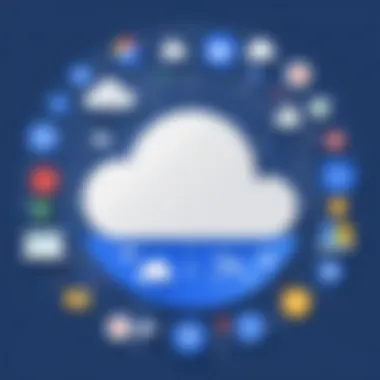Exploring Google Cloud PaaS Services for Developers


Intro
Google Cloud Platform (GCP) offers a range of innovative services to developers and companies working on application development. Among these offerings, Platform as a Service (PaaS) stands out as a significant model. PaaS simplifies and accelerates the development process by providing an environment where developers can build, deploy, and manage applications without worrying excessively about underlying infrastructure. The relevance of this topic cannot be understated, as the technology landscape continues to evolve, making cloud solutions increasingly vital for modern enterprises.
In this article, we explore Google Cloud PaaS services in detail. We examine its core functionalities, advantages, and challenges inherent in its use. Also, we analyze key features and services to understand their impact on contemporary application development. Furthermore, we consider real-world applications, integration with other cloud services, security implications, pricing structures, and foreseeable trends that could shape the future of PaaS users.
Prelude to Google Cloud PaaS
Google Cloud Platform's Platform as a Service (PaaS) offerings have become essential in the rapidly evolving landscape of cloud computing. Understanding these services is critical not just for tech professionals but also for organizations seeking to leverage cloud technology for application development. The role of PaaS in facilitating faster, more efficient software development cannot be understated. It provides the infrastructure and tools needed to build, deploy, and manage applications without the complexities of managing underlying hardware.
Using PaaS can dramatically reduce the time required to develop applications, allowing businesses to focus on innovation rather than maintenance. Moreover, Google Cloud PaaS offers scalable solutions that can adapt to the changing demands of projects. This is particularly valuable for startups and enterprises experiencing growth.
In this section, we will delve into two key components: the definition of PaaS within cloud computing, and the evolution of Google Cloud as a major player in this arena.
Understanding PaaS in Cloud Computing
To grasp the full scope of Google Cloud PaaS, it is imperative to understand what PaaS means in the context of cloud computing. PaaS essentially provides a framework that developers can use to build and deploy applications without worrying about the underlying infrastructure. It allows for clean separation between the development processes and system management. This separation streamlines the development process, making it not only faster but also more efficient.
PaaS offerings often include development tools, middleware, database management systems, and business analytics solutions. The idea is to empower developers to create applications quickly by providing everything they need in one coherent package. This is significant when thinking about collaboration, as remote teams can work together smoothly in a cloud environment. It eliminates the need to set up individual environments on local machines, reducing errors and inconsistencies across different stages of development.
The Rise of Google Cloud
Google Cloud has emerged as a strong contender in the cloud marketplace, competing with giants like Amazon Web Services and Microsoft Azure. Its PaaS offerings are attractive due to their integration with Google's robust infrastructure, which provides reliability and performance benefits. Google’s investment in its data centers and cloud technology is significant, enabling it to maintain a high standard of service for developers and businesses.
The rise of Google Cloud can also be attributed to its commitment to innovation. The company continuously updates its offerings, ensuring they remain relevant to today's development needs. Factors such as support for multiple programming languages, microservices architecture, and advanced machine learning capabilities make Google Cloud PaaS appealing. As more organizations migrate to the cloud, understanding Google Cloud’s PaaS services becomes crucial for leveraging these advantages effectively.
Core PaaS Offerings of Google Cloud
Understanding the core offerings of Google Cloud's Platform as a Service (PaaS) is essential for developers and IT professionals. These offerings simplify the process of application development and implementation by providing a managed platform. This allows users to focus on writing code rather than managing infrastructure. Each of the services mentioned below has unique advantages, enhancing the overall development experience.
Google App Engine
Google App Engine serves as a powerful platform for building and deploying web applications. It offers automatic scaling, which means that applications adjust to traffic demands without manual intervention. This feature is critical for maintaining performance during peak usage times. Developers have the flexibility to use various programming languages, including Python, Java, and Go.
With Google App Engine, users benefit from integrated services such as Google Cloud Datastore, which provides a reliable NoSQL database. Deployment of applications is simplified through a straightforward process using the Google Cloud Console or command-line tools. This service supports both standard and flexible environments, catering to different scalability and customization needs.
Benefits include:
- Easy deployment and scaling.
- Wide array of supported languages.
- Built-in services for data storage and APIs.
Google Cloud Functions
Google Cloud Functions is a serverless execution environment that allows developers to run code in response to events. This service fits well with event-driven architectures. It eliminates the need for server management, streamlining workflows for many applications.
With Google Cloud Functions, you can trigger code from various Google Cloud services, like Cloud Pub/Sub or HTTP requests, making it a versatile choice for integrating different parts of an application. The pricing model is also appealing, as users only pay for the resources consumed during execution.
Key aspects include:
- Fully managed environment without server management.
- Automatic scaling based on incoming events.
- Support for multiple programming languages, including Node.js, Python, and Go.
Cloud Run and Anthos
Cloud Run provides a managed platform to run containers in a serverless environment. This service is ideal for developers who want to deploy containerized applications without worrying about underlying infrastructure. Cloud Run scales automatically based on the requests, providing both ease and efficiency to application deployment.
Anthos adds another dimension to this offering by enabling users to manage applications across different environments—on-premises, Google Cloud, or other cloud providers. This hybrid approach facilitates greater flexibility and control over application deployment strategies.
Key features of Cloud Run and Anthos include:


- Instant scaling of containerized applications.
- Simplified deployment with containerization.
- Centralized management across various environments with Anthos integration.
"The core PaaS offerings of Google Cloud provide developers with a range of powerful tools, which can significantly streamline the process of application development and deployment."
Understanding these core services is crucial for maximizing the capabilities of Google Cloud in modern application development.
Benefits of Using Google Cloud PaaS
Google Cloud's Platform as a Service offers numerous benefits that make it an attractive option for organizations and developers alike. Understanding these advantages is essential for organizations considering leveraging Google Cloud PaaS for their application development needs. The core value of using PaaS lies in its ability to provide a streamlined environment for deploying applications while minimizing infrastructure management overhead.
Scalability and Flexibility
One of the most significant advantages of Google Cloud PaaS is its inherent scalability. Organizations can easily adjust their resources based on current demands. When application usage increases, Google Cloud can automatically allocate more resources. This eliminates the need for manual intervention and allows businesses to focus on development rather than infrastructure. Moreover, the flexibility of this platform ensures that developers can build, deploy, and manage applications in a variety of environments, be it development, testing, or production. Developers can select the best configurations without being constrained by underlying hardware limitations.
Cost-Effectiveness
Cost management is a crucial factor for any organization. With Google Cloud PaaS, businesses can take advantage of a pay-as-you-go pricing model. This means that companies only pay for the resources they actually use, allowing for better budget control and planning. There are no upfront costs or long-term commitments that typically come with traditional infrastructure setups. This cost-effective approach ensures that small startups to large enterprises can utilize PaaS without fear of excessive spending.
Side note: It is common for organizations to underestimate the financial benefits of using PaaS. A careful assessment of costs compared to traditional setups can reveal significant savings over time.
Enhanced Developer Productivity
Google Cloud PaaS significantly improves developer productivity. By offering developers pre-configured environments and tools, they can focus on writing code rather than managing infrastructure. Features such as continuous integration and continuous deployment enable rapid application updates, thus shortening the development cycles. In addition, Google Cloud provides various APIs and built-in services that facilitate seamless integrations with other tools and services. This rich ecosystem supports developers in creating innovative applications efficiently.
"Enhancing developer productivity is not just about tools. It involves creating an environment where developers can thrive and innovate."
This focus on developer efficiency allows teams to work more collaboratively and with fewer interruptions, leading to higher-quality software outputs.
In summary, the benefits of using Google Cloud PaaS are substantial. Scalability, cost-effectiveness, and enhanced productivity are critical factors that organizations must consider when choosing a platform for application development. By leveraging these advantages, businesses can optimize their operations and drive innovation.
Challenges and Limitations of Google Cloud PaaS
Using Google Cloud's PaaS services comes with several challenges and limitations. Recognizing these obstacles is crucial for developers and organizations seeking to optimize their cloud strategy. Addressing these issues can ensure that teams are better equipped to leverage the full potential of Google Cloud while mitigating risks associated with its use.
Vendor Lock-in Concerns
Vendor lock-in is one of the main concerns for users of Google Cloud PaaS. This concept refers to a scenario where a user becomes overly dependent on a particular cloud provider's services, making it difficult to switch to another provider without incurring significant costs or complications.
Google Cloud offers a variety of sophisticated tools, but relying heavily on them can tie organizations into their ecosystem. This situation can lead to several issues:
- Cost Implications: Moving away from Google Cloud may involve substantial financial investments in data migration and re-developing applications tailored to another cloud platform.
- Technical Barriers: Organizations may face technical challenges when trying to adapt their applications for a different environment. Each cloud provider has its own set of tools and operational processes.
- Limited Flexibility: Being locked into one provider can hinder an organization's ability to quickly adopt new technologies or operational practices that are available in other ecosystems.
Businesses must actively plan for exit strategies from the onset of their cloud adoption process. This could involve using containerization technologies, such as Kubernetes, which allow for portability across different cloud environments.
Complexity of Integration
Another challenge is the complexity of integration with existing systems. While Google Cloud PaaS offers many powerful features, bridging these services with on-premises applications or other cloud services can be a daunting task. The integration process involves various considerations:
- Data Synchronization: Ensuring consistent data between cloud services and on-premises solutions often requires complex synchronization tactics, which can lead to inconsistencies.
- APIs and Middleware: Organizations might need additional middleware or APIs to facilitate seamless communication between disparate systems. This adds layers of complexity, requiring specialized skills to manage.
- Performance Issues: Integration can introduce latency or performance bottlenecks if not handled properly. Understanding how to optimize linkages for efficiency is critical.
Organizations should prioritize planning integration efforts early in the development process. Mapping out the system architecture in advance can provide clarity on how services interconnect and highlight potential pitfalls.
Security Considerations for PaaS Users
Security is a fundamental aspect that must be considered when using Google Cloud PaaS services. As organizations increasingly rely on cloud platforms for application development and deployment, the risks related to data security, privacy, and compliance become more pronounced. Understanding these security considerations is not just beneficial; it is essential for maintaining trust and safeguarding sensitive information.
One critical element is data privacy and compliance. Organizations must ensure that their data is handled according to legal standards. In various sectors, compliance with regulations like GDPR or HIPAA is mandatory. The consequences of data breaches can be severe, including financial penalties and reputational damage. Therefore, it is crucial to evaluate how Google Cloud PaaS manages data privacy. Google has protocols in place to help users meet compliance needs. Their services include data encryption both at rest and in transit. Moreover, Google Cloud provides tools to monitor and manage compliance activities effectively.


Another aspect is infrastructure security. With PaaS, users often rely on the underlying cloud infrastructure managed by Google. This abstraction layer can lead to vulnerabilities if not properly secured. Google invests significantly in securing its infrastructure. This includes physical security for data centers, as well as advanced security measures against cyber attacks. Users must also take their own precautions, such as employing identity and access management policies to control who has access to applications and data.
"Security is not a product, but a process."
- Bruce Schneier
Security in Google Cloud PaaS is a shared responsibility. Users must remain proactive in implementing best practices to protect their applications. Regular audits, vulnerability assessments, and logging activities can help maintain a secure environment. Additionally, keeping software and dependencies updated is necessary to protect against known vulnerabilities.
In summary, security considerations for PaaS users extend beyond just the tools provided by Google. They encompass a holistic approach to managing data privacy, compliance, and infrastructure security. Being informed and vigilant prepares organizations to address potential risks effectively.
Pricing Models for Google Cloud PaaS
Understanding the pricing models for Google Cloud's Platform as a Service (PaaS) is essential for businesses and developers considering its use. Pricing can significantly affect the total cost of ownership and ultimately influence the decision to adopt such services. Google Cloud provides flexible pricing structures designed to accommodate various usage patterns. Therefore, recognizing these models helps users to optimize their budgets and predict expenses accurately.
Pay-as-You-Go Pricing
The pay-as-you-go pricing model is one of the core features of Google Cloud's PaaS offerings. This system allows customers to only pay for the resources they actually use. It provides a clear advantage for startups or projects with uncertain workloads. Companies can keep costs low at the beginning, scaling up spending as their needs grow.
For example, if a developer deploys an application that experiences sporadic user traffic, they only incur costs proportional to their actual usage during peak times. When traffic decreases, costs automatically adjust downward. This flexibility is appealing for businesses looking to maintain a lean operational budget.
Key benefits of pay-as-you-go pricing include:
- Low Entry Barrier: Users can start utilizing the services without a substantial upfront investment.
- Cost Efficiency: Customers are rewarded for efficient resource use, creating an incentive to optimize applications.
- Scalability: Businesses can easily scale their resources without the burden of fixed costs.
Additional Cost Factors
While the pay-as-you-go system offers flexibility, users must consider additional cost factors that can influence overall spending. These factors include:
- Data Egress Charges: Often overlooked, transferring data out of Google Cloud can incur significant fees. Understanding the data transfer rates is crucial for applications with high outbound data transfers.
- Operational Costs: Some services may have associated operational costs, such as for logging or monitoring. Users should assess these factors when estimating their budget.
- Service Tiers: Google Cloud offers various service tiers with differing features and pricing. Users may need to evaluate which services fit their needs best.
Evaluating these elements gives users a more comprehensive understanding of potential expenses, allowing for better financial planning and strategy.
"Understanding the pricing models not only aids in budgeting but also in maximizing the value derived from services."
This approach fosters a proactive mindset regarding cost management in Google Cloud PaaS implementations.
Real-World Applications of Google Cloud PaaS
Understanding the real-world applications of Google Cloud's PaaS offerings is crucial. It provides insights into how organizations utilize these services to solve complex problems and achieve their objectives. Google Cloud PaaS enables developers to deploy applications quickly, streamline development processes, and scale effectively. This section explores concrete examples and innovative projects that highlight the benefits and considerations of using Google Cloud PaaS in various industries.
Case Studies in Different Industries
Several industries have adopted Google Cloud PaaS to enhance their operations. These case studies illustrate its versatility and effectiveness.
- Healthcare: A leading healthcare provider used Google App Engine to develop a patient management system. By leveraging PaaS, the organization could rapidly prototype, test, and deploy applications. This improved patient care by providing staff easy access to patient records and analytics.
- Finance: A financial services company implemented Google Cloud Functions to automate their risk assessment processes. The event-driven architecture allowed the firm to respond to market changes immediately. This efficiency led to faster decision-making and reduced operational costs.
- Retail: An ecommerce company utilized Cloud Run to host its shopping portal. The ability to handle sudden traffic spikes during sales events was critical. It provided a seamless shopping experience, boosting sales and customer satisfaction.
These diverse examples illustrate how Google Cloud PaaS meets specific industry needs, driving innovation and operational excellence.
Startups Leveraging Google Cloud PaaS
Startups are often under pressure to innovate rapidly and cost-effectively. Google Cloud PaaS provides them with the tools to do exactly that. Many startups can focus on core business functions instead of worrying about infrastructure.
- Development Speed: Startups can launch their MVPs quickly using Google App Engine, which reduces time-to-market. For example, a startup in the fintech space accelerated its development cycle by utilizing PaaS, allowing it to capture market share early.
- Cost Efficiency: With a pay-as-you-go model, startups can manage costs effectively. One startup focused on app development tailored its expenses to its growth, avoiding heavy upfront investments.
- Scalability: Startups can easily scale their applications based on user demand. A popular social media startup on Google Cloud found it easy to manage rapid growth without compromising performance.
These real-world applications exhibit how Google Cloud PaaS not only transforms businesses but also supports new ventures heavily relying on agility and efficiency.
Integration with Other Google Cloud Services


Integrating Google Cloud Platform's Platform as a Service (PaaS) offerings with other Google Cloud services is crucial for maximizing performance and functionality. The seamless connection enhances the overall utility of cloud solutions for software developers, IT professionals, and businesses. It allows for improved process automation, data flow, and application management, creating a comprehensive ecosystem that meets diverse operational needs.
Connecting PaaS with IaaS and SaaS
The combination of PaaS, Infrastructure as a Service (IaaS), and Software as a Service (SaaS) offers significant advantages. By leveraging Google Compute Engine, part of its IaaS, developers can manage scalable virtual machines. This integration enables PaaS applications to run efficiently and effectively while utilizing Google's robust infrastructure.
Benefits of this connection include:
- Optimized resource utilization: Developers can allocate resources as needed, scaling up or down depending on application demands.
- Cost efficiency: Combining services allows businesses to minimize the need for redundant resources, which lowers operational costs.
- Simplified management: Developers can deploy applications in PaaS, while still having the flexibility to manage underlying infrastructure when necessary.
Companies can deploy applications through Google App Engine while ensuring their data storage and processing relies on Google Cloud Storage and Google BigQuery. This fosters a more dynamic application and service environment.
Using APIs for Enhanced Functionality
APIs are an essential component of Google Cloud services, allowing for powerful integrations that enhance application capabilities. By utilizing Google Cloud APIs, developers can facilitate communication between various services. This capability is critical for crafting responsive applications and providing users with a rich experience.
APIs facilitate:
- Seamless data exchange: They enable disparate systems to share data easily, allowing for comprehensive analytics and reporting.
- Feature enhancement: By integrating Google Maps API, for instance, developers can include geolocation features in their applications, significantly improving user engagement.
- Automated workflows: APIs can automate processes like triggering notifications or conducting health checks on applications, which saves time and reduces errors.
"Integrating different services via APIs can elevate the immediacy and relevance of applications and boost overall productivity."
Future Trends in PaaS
Understanding the future trends in Platform as a Service (PaaS) is crucial for stakeholders involved in cloud computing. This section will touch on emerging technologies and market shifts that are likely to influence PaaS services in the coming years. Knowing these trends helps organizations adapt and stay competitive, enabling them to make informed decisions when developing applications.
The Impact of AI and Machine Learning
AI and machine learning are transforming various sectors, and PaaS is not an exception. Integrating these technologies into PaaS can enhance the efficiency and capabilities of cloud solutions. Companies can leverage AI for automating tasks, providing predictive analytics, and improving decision-making processes.
- Automation: PaaS platforms are increasingly incorporating AI to automate workflows. This minimizes human errors and saves time, allowing developers to focus on more complex tasks.
- Predictive Analytics: Machine learning algorithms can analyze historical data to predict future performance. This enables proactive resource allocation, optimizing costs and performance.
- Enhanced User Experience: AI can personalize applications by analyzing user behavior, providing tailored experiences. This is particularly beneficial in sectors such as e-commerce and finance, where user engagement is critical.
The implications of this trend are significant for developers and companies seeking to optimize their applications. They will need to stay abreast of the latest developments in AI and integrate these capabilities into their PaaS strategies.
"AI is paving the way for more intelligent cloud services, making PaaS more accessible and efficient for developers."
Shifts in Market Dynamics
The cloud market is evolving rapidly, influenced by technological advancements and changing business needs. These shifts impact how PaaS is developed and consumed.
- Increased Adoption of Hybrid and Multi-Cloud Environments: Organizations are gravitating towards multi-cloud strategies. They choose the best services from various providers to meet their specific requirements. PaaS solutions will need to adapt to facilitate seamless integration across different clouds.
- Focus on Open Source Technologies: Open source development is gaining traction among developers. PaaS platforms that embrace open source can attract a broader user base and foster innovation. Developers benefit from the flexibility to customize solutions based on their needs.
- Emphasis on Sustainability: Companies are recognizing the importance of sustainable practices. PaaS providers will likely adopt eco-friendly solutions to attract environmentally conscious clients. Energy efficiency in data centers and reducing carbon footprints will become focal points.
Adapting to these shifts is essential for businesses aiming to leverage PaaS effectively. As market dynamics change, remaining flexible and responsive to trends will enable organizations to harness the full potential of cloud computing.
End
In this final section, we reflect on the crucial insights of Google Cloud's PaaS offerings. It is essential to recognize how these services shape modern application development. Google Cloud PaaS simplifies the complexity found in software deployment and management. Developers can focus on writing code and deploying applications without getting bogged down by infrastructure concerns.
Summarizing Key Points
Google Cloud PaaS stands out due to several key aspects:
- Scalability and Flexibility: Developers can easily scale applications based on demand without significant reconfigurations.
- Enhanced Developer Productivity: Tools like Google App Engine allow for quicker testing and deployment, streamlining the development process.
- Integration Capabilities: Seamless connections with other Google Cloud services enable richer functionalities.
- Security Measures: Comprehensive security protocols ensure the safety of user data.
In summary, the core offerings of Google Cloud PaaS deliver robust solutions for companies looking to innovate and enhance their digital capabilities. The flexibility and efficiency gained are decisive in staying competitive in fast-paced markets.
Looking Ahead
The future of Google Cloud PaaS looks promising. Several trends warrant attention:
- AI and Machine Learning Integration: As artificial intelligence continues to evolve, PaaS offerings will increasingly incorporate AI tools, providing developers with advanced capabilities.
- Market Dynamics: The competitive landscape is changing, with more businesses seeking efficient cloud solutions. Google Cloud is likely to adapt by enhancing its features and offerings.
Developers and IT professionals should remain aware of these developments. Keeping up with these trends will ensure that they can leverage Google Cloud's PaaS services effectively.
"The transition to cloud is not just about technology, but a shift in operational mindset."







